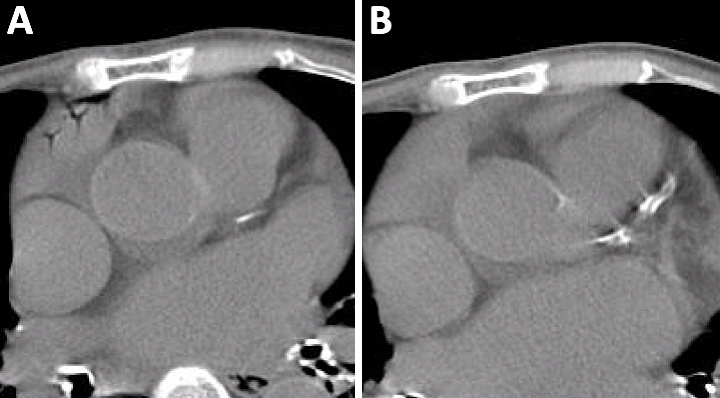Corresponding author: Ryo Tanabe, p5f56ozs@okayama-u.ac.jp
DOI: 10.31662/jmaj.2020-0025
Received: April 3, 2020
Accepted: July 20, 2020
Advance Publication: October 2, 2020
Published: October 15, 2020
Cite this article as:
Tanabe R, Matsuura H, Otsuka Y, Endo A. Dynamic Mercedes-Benz Sign in the Right Atrium. JMA J. 2020;3(4):353-354.
Key words: Dynamic Mercedes Benz sign, Venous air embolism, Venipuncture
An 87-year-old woman with an acute history of fever and cough presented to our emergency department. Non-contrast chest computed tomography (CT) revealed the unexpected presence of air in the right atrium (Figure 1A). Air embolisms in the heart are observed as the Mercedes-Benz sign (1), which is commonly observed in gallstones. This sign is not usually detected via electrocardiography-synchronized CT because its motion artifact is due to the heartbeat. They are detected via unenhanced chest CT in no less than 5.5% of asymptomatic patients after securing a peripheral venous line (2). Patients with a patent foramen ovale are at a risk of end-organ ischemia due to venous air embolism. Clinicians should be aware of the possible complication of venipuncture and should carefully follow-up patients who present with a Mercedes-Benz sign regardless of additional symptoms, such as paralysis. Our patient did not exhibit additional symptoms. Air was not observed on the follow-up CT 2 days later (Figure 1B).

None
Ryo Tanabe contributed to manuscript preparation, patient care, and discussion. Hiroki Matsuura, Yuki Otsuka, Akira Endo contributed to the discussion on the definitive diagnosis.
Informed consent has been obtained from the patient for the publication of their information, including photographs.
This study did not require IRB approval.
Emby DJ, Ho K. Air embolus revisited―a diagnostic and interventional radiological perspective (bubble trouble and the dynamic Mercedes Benz sign). South African J Radiol. 2006;10(1):3-7.
Groell R, Schaffler GJ, Rienmueller R, et al. Vascular air embolism: location, frequency, and cause on electron beam CT studies of the chest. Radiology. 1997;202(2):459-62.